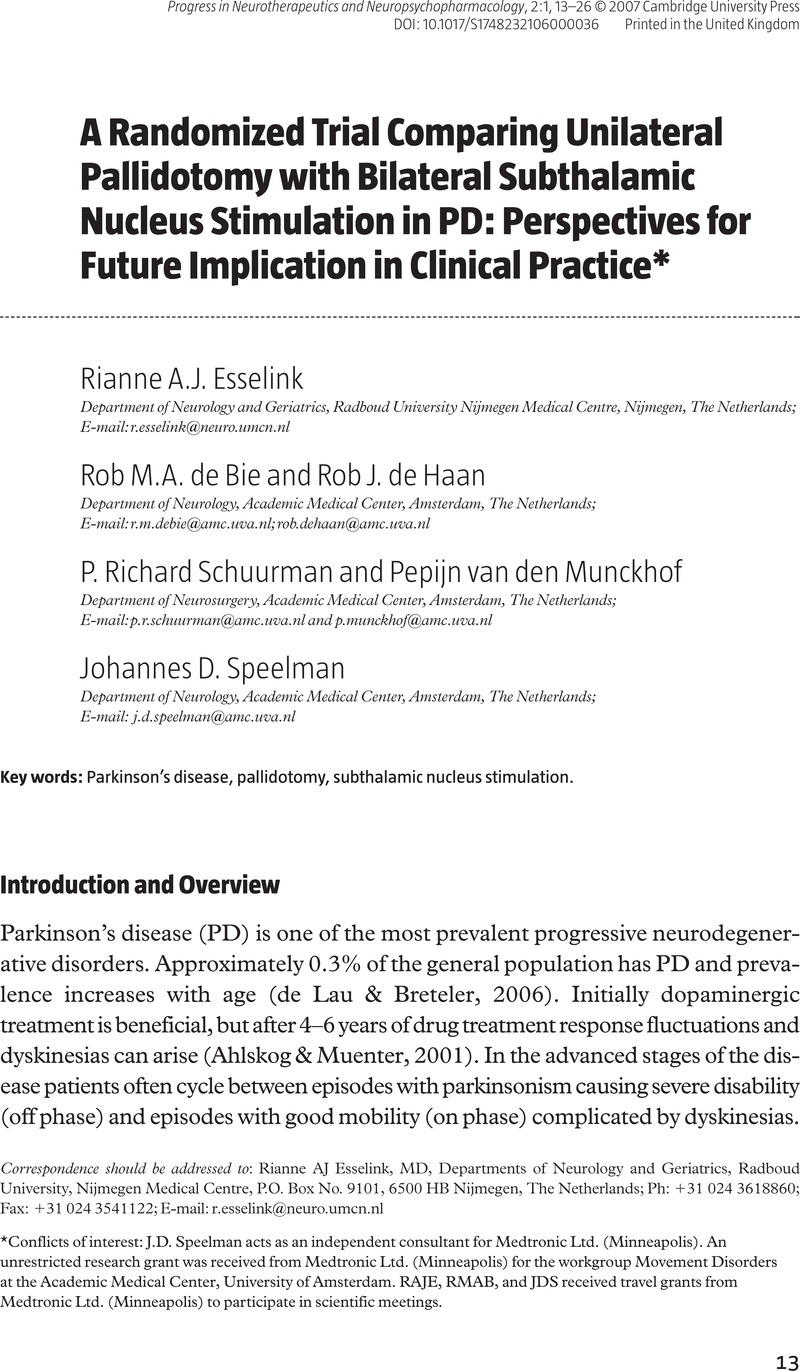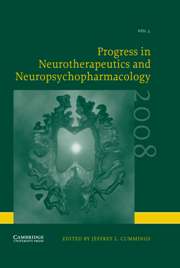No CrossRef data available.
Article contents
A Randomized Trial Comparing Unilateral Pallidotomy with Bilateral Subthalamic Nucleus Stimulation in PD: Perspectives for Future Implication in Clinical Practice
Published online by Cambridge University Press: 29 June 2006
Abstract
An abstract is not available for this content so a preview has been provided. Please use the Get access link above for information on how to access this content.

- Type
- Review Article
- Information
- Progress in Neurotherapeutics and Neuropsychopharmacology , Volume 2 , Issue 1 , March 2007 , pp. 13 - 26
- Copyright
- © 2007 Cambridge University Press
Footnotes
Conflicts of interest: J.D. Speelman acts as an independent consultant for Medtronic Ltd. (Minneapolis). An unrestricted research grant was received from Medtronic Ltd. (Minneapolis) for the workgroup Movement Disorders at the Academic Medical Center, University of Amsterdam. RAJE, RMAB, and JDS received travel grants from Medtronic Ltd. (Minneapolis) to participate in scientific meetings.
References
Ahlskog, J.E., & Muenter, M.D. (2001). Frequency of levodopa-related dyskinesias and motor fluctuations as estimated from the cumulative literature. Movement Disorders, 16, 448–458.Google Scholar
Alvarez, L., Macias, R., Lopez, G., et al. (2005). Bilateral subthalamotomy in Parkinson's disease: initial and long-term response. Brain, 128, 570–583.Google Scholar
Anderson, V.C., Burchiel, K.J., Hogarth, P., Favre, J., & Hammerstad, J.P. (2005). Pallidal vs subthalamic nucleus deep brain stimulation in Parkinson disease. Archives of Neurology, 62, 554–560.Google Scholar
Benazzouz, A., Breit, S., Koudsie, A., Pollak, P., Krack, P., & Benabid, A.L. (2002). Intraoperative microrecordings of the subthalamic nucleus in Parkinson's disease. Movement Disorders, 17 (Suppl. 3), S145–S149.Google Scholar
Bonnet, A.M., Loria, Y., Saint-Hilaire, M.H., Lhermitte, F., & Agid, Y. (1987). Does long-term aggravation of Parkinson's disease result from nondopaminergic lesions? Neurology, 37, 1539–1542.Google Scholar
Burchiel, K.J., Anderson, V.C., Favre, J., & Hammerstad, J. (1999). Comparison of pallidal and subthalamic nucleus deep brain stimulation for advanced Parkinson's disease: results of a randomized, blinded pilot study. Neurosurgery, 45, 1375–1384.Google Scholar
de Bie, R.M.A., de Haan, R.J., Nijssen, P.C.G., et al. (1999). Unilateral pallidotomy in Parkinson's disease: a randomised, single-blind, multicentre trial. Lancet, 354, 1665–1669.Google Scholar
de Bie, R.M.A., Schuurman, P.R., Esselink, R.A.J., Bosch, D.A., & Speelman, J.D. (2002). Bilateral pallidotomy in Parkinson's disease: a retrospective study. Movement Disorders, 17, 533–538.Google Scholar
de Boer, A.G.E.M., Wijker, W., Speelman, J.D., & de Haes, J.C.J.M. (1996). Quality of life in patients with Parkinson's disease: development of a questionnaire. Journal of Neurology Neurosurgery and Psychiatry, 61, 70–74.Google Scholar
de Lau, L.M., & Breteler, M.M. (2006). Epidemiology of Parkinson's disease. Lancet Neurology, 5, 525–535.Google Scholar
Esselink, R.A.J., de Bie, R.M., de Haan, R.J., et al. (2004). Unilateral pallidotomy versus bilateral subthalamic nucleus stimulation in Parkinson's disease: a randomised, observer-blind, multi-centre trial. Neurology, 62, 201–207.Google Scholar
Fahn, S., Elton, R.L., & Members of the UPDRS Development Committee (1987). Unified Parkinson's disease rating scale. In: Fahn, S., Marsden, C.D., & Calne, D.B. (eds.), Recent Developments in Parkinson's Disease. Florham Park, NJ: Macmillan Healthcare Information, pp. 153–163.
Gelb, D.J., Oliver, E., & Gilman, S. (1999). Diagnostic criteria for Parkinson disease. Archives of Neurology, 56, 33–39.Google Scholar
Ghika, J., Ghika-Schmid, F., Fankhauser, H., et al. (1999). Bilateral contemporaneous posteroventral pallidotomy for the treatment of Parkinson's disease: neuropsychological and neurological side effects. Report of four cases and review of the literature. Journal of Neurosurgery, 91, 313–321.Google Scholar
Hagell, P., & Widner, H. (1999). Clinical rating of dyskinesias in Parkinson's disease: use and reliability of a new rating scale. Movement Disorders, 14, 448–455.Google Scholar
Hariz, M.I., & Fodstad, H. (1999). Do microelectrode techniques increase accuracy or decrease risks in pallidotomy and deep brain stimulation? A critical review of the literature. Stereotactic and Functional Neurosurgery, 72, 157–169.Google Scholar
Hoehn, M.M., & Yahr, M.D. (1967). Parkinsonism: onset, progression and mortality. Neurology, 17, 427–442.Google Scholar
Houeto, J.L., Damier, P., Bejjani, B.P., et al. (2000). Subthalamic stimulation in Parkinson's disease: a multidisciplinary approach. Archives of Neurology, 57, 461–465.Google Scholar
Jenkinson, N., Nandi, D., Aziz, T.Z., & Stein, J.F. (2005). Pedunculopontine nucleus: a new target for deep brain stimulation for akinesia. Neuroreport, 16, 1875–1876.Google Scholar
Krack, P., Pollak, P., Limousin, P., et al. (1998). Subthalamic nucleus or internal pallidal stimulation in young onset Parkinson's disease. Brain, 121, 451–457.Google Scholar
Krack, P., Batir, A., Van Blercom, N., et al. (2003). Five-year follow-up of bilateral stimulation of the subthalamic nucleus in advanced Parkinson's disease. New England Journal of Medicine, 349, 1925–1934.Google Scholar
Krause, M., Fogel, W., Heck, A., et al. (2001). Deep brain stimulation for the treatment of Parkinson's disease: subthalamic nucleus versus globus pallidus internus. Journal of Neurology Neurosurgery and Psychiatry, 70, 464–470.Google Scholar
Kumar, R., Lozano, A.M., Kim, Y.J., et al. (1998). Double-blind evaluation of subthalamic nucleus deep brain stimulation in advanced Parkinson's disease. Neurology, 51, 850–855.Google Scholar
Laitinen, L.V., Bergenheim, A.T., & Hariz, M.I. (1992). Leksell's posteroventral pallidotomy in the treatment of Parkinson's disease. Journal of Neurosurgery, 76, 53–61.Google Scholar
Lang, A.E., & Widner, H. (2002). Deep brain stimulation for Parkinson's disease: patient selection and evaluation. Movement Disorders, 17 (Suppl. 3), S94–S101.Google Scholar
Lang, A.E., Lozano, A.M., Montgomery, E.B., Duff, J., Tasker, R.R., & Hutchinson, W.D. (1997). Posteroventral medial pallidotomy in advanced Parkinson's disease, New England Journal of Medicine, 337, 1036–1042.Google Scholar
Lee, M.S., & Marsden, C.D. (1994). Movement disorders following lesions of the thalamus or subthalamic region. Movement Disorders, 9, 493–507.Google Scholar
Limousin, P., Krack, P., Pollak, P., et al. (1998). Electrical stimulation of the subthalamic nucleus in advanced Parkinson's disease. New England Journal of Medicine, 339, 1105–1111.Google Scholar
Lozano, A.M., & Hutchison, W.D. (2002). Microelectrode recordings in the pallidum. Movement Disorders, 17 (Suppl. 3), S150–S154.Google Scholar
Markham, C.H., & Diamond, S.G. (1986). Modification of Parkinson's disease by long-term levodopa treatment. Archives of Neurology, 43, 405–407.Google Scholar
Mattis, S. (1976). Mental status examination for organic mental syndrome in the elderly patient. In: Bellak, L., & Karasu, T.B. (eds.), Geriatric Psychiatry: A Handbook for Psychiatrists and Primary Care Physicians. New York: Grune & Stratton, pp. 77–121.
Mazzone, P., Lozano, A., Stanzione, P., et al. (2005). Implantation of human pedunculopontine nucleus: a safe and clinically relevant target in Parkinson's disease. Neuroreport, 16, 1877–1881.Google Scholar
Merello, M., Starkstein, S., Nouzeilles, M.I., Kuzis, G., & Leiguarda, R. (2001). Bilateral pallidotomy for treatment of Parkinson's disease induced corticobulbar syndrome and psychic akinesia avoidable by globus pallidus lesion combined with contralateral stimulation. Journal of Neurology Neurosurgery and Psychiatry, 71, 611–614.Google Scholar
Moro, E., Scerrati, M., Romito, L.M.A., Roselli, R., Tonali, P., & Albanese, A. (1999). Chronic subthalamic nucleus stimulation reduces medication requirements in Parkinson's disease. A multidisciplinary approach. Neurology, 53, 85–90.Google Scholar
Patel, N.K., Heywood, P., O'sullivan, K., McCarter, R., Love, S., & Gill, S.S. (2003). Unilateral subthalamotomy in the treatment of Parkinson's disease. Brain, 126, 1136–1145.Google Scholar
Plaha, P., & Gill, S.S. (2005). Bilateral deep brain stimulation of the pedunculopontine nucleus for Parkinson's disease. Neuroreport, 16, 1883–1887.Google Scholar
Rodriguez-Oroz, M.C., Zamarbide, I., Guridi, J., Palmero, M.R., & Obeso, J.A. (2004). Efficacy of deep brain stimulation of the subthalamic nucleus in Parkinson's disease 4 years after surgery: double blind and open label evaluation. Journal of Neurology Neurosurgery and Psychiatry, 75, 1382–1385.Google Scholar
Rodriguez-Oroz, M.C., Obeso, J.A., Lang, A.E., et al. (2005). Bilateral deep brain stimulation in Parkinson's disease: a multicentre study with 4 years follow-up. Brain, 128, 2240–2249.Google Scholar
Schupbach, W.M., Chastan, N., Welter, M.L., et al. (2005). Stimulation of the subthalamic nucleus in Parkinson's disease: a 5 year follow up. Journal of Neurology Neurosurgery and Psychiatry, 76, 1640–1644.Google Scholar
Schuurman, P.R., Bosch, D.A., Bossuyt, P.M., et al. (2000). A comparison of continuous thalamic stimulation and thalamotomy for suppression of severe tremor. New England Journal of Medicine, 342, 461–468.Google Scholar
Sterio, D., Zonenshayn, M., Mogilner, A.Y., et al. (2002). Neurophysiological refinement of subthalamic nucleus targeting. Neurosurgery, 50, 58–67.Google Scholar
Su, P.C., Tseng, H.M., Liu, H.M., Yen, R.F., & Liou, H.H. (2003). Treatment of advanced Parkinson's disease by subthalamotomy: one-year results. Movement Disorders, 18, 531–538.Google Scholar
The Deep-Brain Stimulation for Parkinson's Disease Study Group (2001). Deep-brain stimulation of the subthalamic nucleus or the pars interna of the globus pallidus in Parkinson's disease. New England Journal of Medicine, 345, 956–963.
Vilela, F.O., Silva, D.J., Souza, H.A., et al. (2001). Stereotactic subthalamic nucleus lesioning for the treatment of Parkinson's disease. Stereotactic and Functional Neurosurgery, 77, 79–86.Google Scholar
Vitek, J.L., Bakay, R.A., Freeman, A., et al. (2003). Randomized trial of pallidotomy versus medical therapy for Parkinson's disease. Annals of Neurology, 53, 558–569.Google Scholar
Volkmann, J., Allert, N., Voges, J., Weiss, P.H., Freund, H-J., & Sturm, V. (2001). Safety and efficacy of pallidal or subthalamic nucleus stimulation in advanced PD. Neurology, 56, 548–551.Google Scholar
Welter, M.L., Houeto, J.L., Tezenas du, M.S., et al. (2002). Clinical predictive factors of subthalamic stimulation in Parkinson's disease. Brain, 125, 575–583.Google Scholar
Whittier, J.R., & Mettler, F.A. (1949). Studies on subthalamus of rhesus monkey: hyperkinesia and other physiologic effects of subthalamic lesions, with special reference to the subthalamic nucleus of Luys. Journal of Comparative Neurology, 90, 319–372.Google Scholar




